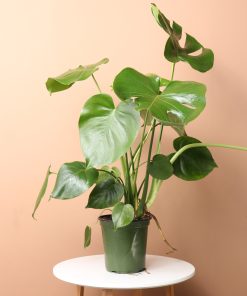The Ponytail Palm in our greenhouse is a truly beautiful plant from the tropics in eastern Mexico. We do next day shipping for customers across the USA in plant-friendly packaging. Ponytail Palms are such stunners that they became loved in Europe and then that love quickly spread around all over the world. Also known as the Beaucarnea recurvata, the Ponytail Palm is an easy to grow resilient plant that can withstand long periods without water. In the Palm’s natural habitat, it can grow very large, reaching approximately 30 feet tall under the right circumstances. Other names for this plant are the Elephant’s Foot and Bottle Palm.
Ponytail Palm Benefits
The Palm’s trunk is thick and can store water inside, making the plant resistant to drought. Another benefit is that it’s easy to grow and its leaves will begin to change color when unhappy.Even when the leaves begin to change, the plant is very forgiving and will bounce back quickly. On top of all that, the Ponytail Palm has the ability to clean the air around it, as it can get rid of air toxins.
Desert Tree
Just kidding. It’s actually not a palm, nor a tree, it’s a member of the Agave family, originates in the deserts, and is technically a succulent. The name can be quite deceiving and really only refers to its thick trunk and tree-like appearance. While most in the Agave family tend to grow very slowly, the Ponytail Palm breaks the mold and can reach larger sizes quicker.
Ponytail Leaves
The foliage on the Ponytail Palm really lives up to its name. The long, thin, wispy leaves spill outwards and curve down, looking exactly like a ponytail or a horse’s tail. Leaves will grow in dense clusters that can sometimes give it the appearance of a mop. When the plant is unhappy, its ponytail leaves will begin to turn brown on the tip. If this happens, you can cut off the brown to clean it up a bit. Next, you should probably find the cause of the discoloration. It could help to check the soil, how much you’re watering, and sunlight conditions to make sure the plant is living in the right conditions. It’s very sensitive to overwatering, so be careful not to drown it. Give us a call if your Palm’s leaves keep turning brown, but you can’t figure out the cause.
Elephant’s Foot
In its natural habitat, the Ponytail Palm can grow over 30 feet tall. Due to its appearance and large size, other names for this plant include Elephant’s Foot Tree because when the trunk reaches its large size, it looks like the leg and foot of an elephant. The base of the trunk is distended as well, which means it’s wider than the rest of it. Some trunk bases can get to be 4 feet wide, giving it even more the look of an elephant’s foot.
Now that you’re an expert with the Ponytail Palm, order this plant by 7PM est to get this plant shipped out of our greenhouse in New Jersey tomorrow (if you are wondering the arrival time, check with the zipcode validator on top of the Add To Cart). Seriously, our plant shipping solution is truly protective and innovative to ensure your plants arrive safe and intact! In case you were still wondering, we WILL send out the EXACT plant that you picked out, just like that of a local nursery or garden center, except we have more and fresher plants to choose from and you can’t find our PAFE fine ceramic planter options anywhere else other than our website 🙂
For any other questions or concerns, please don’t hesitate to reach out to us
























